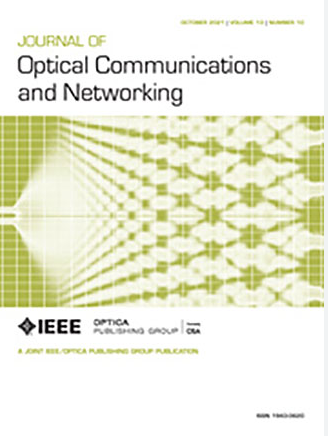PCA-assisted clustering approaches for soft-failure detection in optical networks
IF 4.3
2区 计算机科学
Q1 COMPUTER SCIENCE, HARDWARE & ARCHITECTURE
引用次数: 0
Abstract
Over the past years, the emergence of complex and bandwidth-hungry applications has charged the efforts to ensure the reliability of optical networks. Moreover, network scalability issues pose challenges as the number of optical parameters increases rapidly. In this regard, it is important to minimize the risk of optical failures by providing an autonomous and scalable failure detection approach. Hence, this paper presents a scalable and interpretable failure detection in optical networks exploiting five clustering algorithms (K-means, fuzzy C-means, Gaussian mixture model, DBSCAN, and mean shift) assisted by a dimensionality reduction technique. Cluster-based approaches facilitate the physical interpretability of the failure distributions among the telemetry data by allowing their clear visualization. Meanwhile, the dimensionality reduction technique can handle large-scale telemetry data with numerous optical parameters, improving the performance of clustering algorithms, as these have limitations when dealing with high-dimensional data. The proposed approaches are evaluated based on Type I/II errors (commonly known as false positive and false negative indications, respectively). A dataset derived from an optical testbed is used to evaluate the robustness of the proposed approaches.基于pca的光网络软故障检测聚类方法
在过去的几年里,复杂和带宽消耗巨大的应用程序的出现,已经为确保光网络的可靠性付出了巨大的努力。此外,随着光参数数量的迅速增加,网络的可扩展性问题也带来了挑战。在这方面,重要的是通过提供自主和可扩展的故障检测方法来最大限度地降低光学故障的风险。因此,本文利用五种聚类算法(K-means、模糊C-means、高斯混合模型、DBSCAN和mean shift),在降维技术的辅助下,提出了一种可扩展和可解释的光网络故障检测方法。基于聚类的方法使遥测数据中的故障分布清晰可见,从而促进了故障分布的物理可解释性。同时,降维技术可以处理具有众多光学参数的大规模遥测数据,提高了聚类算法在处理高维数据时的性能。建议的方法是基于I/II型错误(分别称为假阳性和假阴性指征)进行评估的。从光学试验台获得的数据集用于评估所提出方法的鲁棒性。
本文章由计算机程序翻译,如有差异,请以英文原文为准。
求助全文
约1分钟内获得全文
求助全文
来源期刊
CiteScore
9.40
自引率
16.00%
发文量
104
审稿时长
4 months
期刊介绍:
The scope of the Journal includes advances in the state-of-the-art of optical networking science, technology, and engineering. Both theoretical contributions (including new techniques, concepts, analyses, and economic studies) and practical contributions (including optical networking experiments, prototypes, and new applications) are encouraged. Subareas of interest include the architecture and design of optical networks, optical network survivability and security, software-defined optical networking, elastic optical networks, data and control plane advances, network management related innovation, and optical access networks. Enabling technologies and their applications are suitable topics only if the results are shown to directly impact optical networking beyond simple point-to-point networks.

 求助内容:
求助内容: 应助结果提醒方式:
应助结果提醒方式:


